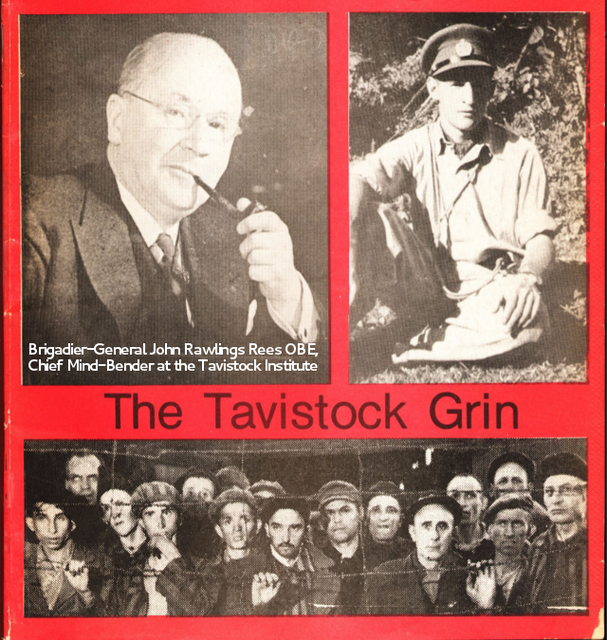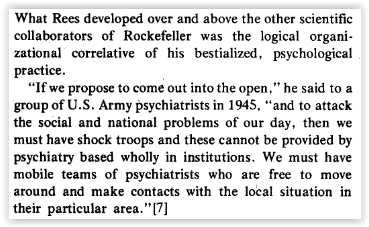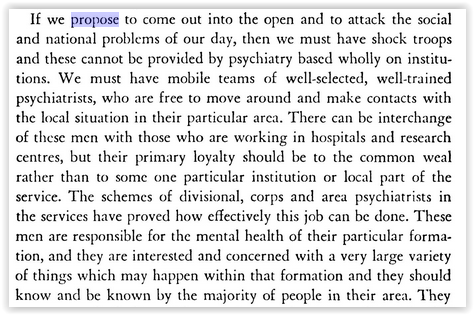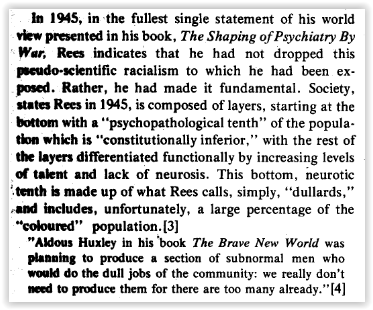This I publish first to give a very concise overview which is memorizable. I don’t even know yet if the full text will fit into one steemit article; it will have a TOC. Please excuse my English.
It all started
with the James Corbett video (timestamp 49:30-57:30) where he alluded to, if anyone knew something more concretely about the Tavistock theories, where it comes from, give some hints.
I heard of Tavistock before, probably from Jay Dyer most concretely (who has it from a Daniel Estulin book) but about those two and their take in the full article.
Anyway, I had several documents saved on my computer (which I never read until now) which are very similar to those in an archive link. I started from there, trying to find out, if I could find a) something actually credible (e.g. direct research from Tavistock itself) and b) find out where the Tavistock=nefarious theories came from.
One central source
is the one James mentions in the talk: John Coleman.
In Committee of 300 and in The Tavistock Institute of Human Relations.
I quickly diverged from that, because everybody knows that this is just a bunch of nonsense and also James already clarified that and there was a much more interesting looking source which came up far more often: The LaRouche organization/cult.
LaRouche
also known as Executive Intelligence Review (EIR) or the Schiller Institute or The Campaigner or fidelio and several other names for institutes or magazines.
A reason article on the death of Lyndon LaRouche earlier this year, the founder of this organization/cult.
The Schiller Institute has a heavy presence in Germany, so German readers, be informed about that.
I read then several LaRouche texts and as from time to time the own texts of the magazines are cited, I finally came back to the original issues where this probably stems from on the LaRouche side.
Here you can see all Campaigner covers.
It is about the 1974 issues with The Tavistock Grin in title (red and orange), announced an issue earlier.
As via this page the issues are difficult to read (page by page), I’ll give the links to the full documents too: April 1974, red and the May 1974 orange issue as pdf.

What I have found
Especially in the first issues, we find actual quotes from actual books from practitioners at Tavistock in London, for example J.D.Rees’ The Shaping of Psychiatry by War. Thus the Campaigner authors made actual efforts to look up and read actual books.
In later issues we’ll see more of two-five word quotes (sometimes wrong), e.g. social turbulence (LaRouche) Link and turbulent fields (Emery and Trist) Link (in the third part General Outcomes). These „quotes“ are often totally unspecific and without context.
Often there are no pages for quotes and a chapter for context is (close to) never named.
In general most of the quotes are put into a context of the LaRouche story-teller and taken absolutely out of context of the original.
All these LaRouche texts were full of polemics and polemics, name-dropping and term-dropping. Repetition and jumping from one allegation to the next at the same time. And these magazines are issues with 50-90 pages.
There is usually some truth to it, e.g. at Tavistock shell-shock was studied or a Rockefeller institution gave grants. In other words, it partially is a very sophisticated enterprise (effort put into, as mentioned) by the LaRouche authors to spin their accusations.
Books and authors which are named are usually prominent and somewhat interesting, e.g. Alvin Toffler, Future Shock, Marilyn Ferguson, Aquarian Conspiracy, Kenneth Boulding, others.
Interviews can be fake/’Tavistock inside sources’.
„The Tavistock Grin“ is basically an invention by the LaRouche-guys.
Examples
Three true quotes
Link (not 100% though, e.g. an unnecessary ..., a ending of a sentence with a point where it continues in the original). Meant are here the quotes of 11, 22 and 66, all from Henry Dicks’ Fifty Years at Tavistock.
The context obviously changes the statements a lot again but about that not in this paragraph.
A quote wish is basically true but not accurate
[7] of this LaRouche issue, p. 38, p. 39 pdf.
Rees himself p. 133 book.
Apart from the omission of „well-selected, well-trained“ a correct quote.
True quote (same issue, same page p. 38, p. 39 pdf) but let’s see the wider context

Context LaRouche
(The wider context looks even worse, with its polemics beforehand and one word quotes, see for yourself.)
Context Rees
[3] is said to be p. 43 and [4] p. 45 in Rees’ book.
That with the tenth of the population (no psychopathological) as dullards I already had seen before (see below). But here is now coloured alleged.
Coloured comes up on p. 45 (that’s it, only one other entry which is not in regards to coloured people). How it is phrased by the LaRouche author is quite a stretch.
To give a glimpse in how Rees described and saw this in his book:
(p. 45)
(end of p. 43, not about coloured people)
(p. 44, second paragraph, not about coloured people)
Now more about the dullards.
I originally encountered it in a LaRouche text.
In his 1945 book, The Shaping of Psychiatry by War, Rees reported that the work of the Tavistock group during the war demonstrated conclusively that there was a "psychopathological tenth" of the population who were genetically dullards. (p. 2 pdf, p. 25)
Psychopathological appears two times in the searches but not in the connection with a tenth or otherwise the context delivered by Wolfe (the LaRouche author).
Upon examining the searches for dullard and tenth I could conclude that Rees did write about a „psychopathic tenth of the community“ (p. 43) and about dullards (p. 42-44, amongst others).
My impression upon reading the pages 42-44 is, that Rees wanted to keep dullards out of the army or formulated ideas how to get along with them. Not:
These dullards, should their numbers not be controlled, would soon dominate civil society. It were therefore necessary to devise methods, using psychiatry, to control such people and prevent their increase in numbers, [...] (p. 2 pdf, p. 25)
But I would have to read the whole book to be really certain about this, which I won’t do for some such short passages.
Further quote on the same LaRouche page:
Psychiatrists, Rees said, must be involved in all levels of society, prepared to intervene at any place-the home, the job, the schools-at any time. "If we propose to come out into the open," wrote Rees, "and to attack the social and national problems of our day, then we must have shock troops, and these cannot be provided by psychiatry based wholly on institutions. We must have teams of well-selected, well-trained psychiatrists, who are free to move around and make contacts with the local situation in their particular area."
The quote is real again (p. 133; p. 132 „psychopathic tenth“) but the formulation 'at any place the home, the job, the schools at any time', is lacking.
Rees's book was based on a series of lectures that he gave to his networks in the United States.“
Looks correct from the foreword.
All the rest afterwards are over-blown or too vague claims (to difficult to deny or prove or put into an accurate perspective).
Example on turbulence
Eric Trist [...] was perfecting a theory of brainwashing on a societal scale, known as "social turbulence," based on the work of Lewin and William Sargant. [...] He stated in his 1963 paper, presented with his co-thinker Fred Emery [...], later published in a short book, A Choice of Futures, that a series of sharp and universal, cathartic shocks would destabilize a targetted population, plunging a whole society into a form of managed psychosis. [...] Trist boldly "predicted" in late 1963 that society had entered into a period of permanent social turbulence, which would usher society into a new paradigm.“ p. 23f.
https://larouchepub.com/eiw/public/1996/eirv23n03-19960112/eirv23n03-19960112.pdf
There is only one paper by Emery and Trist together from about this time and that is from 1965, called The Causal Texture of Organizational Environments.
It has nothing to do with the alleged and mentions instead turbulent fields and turbulent environments.
We also have the book A Choice of Futures by Emery and Emery (Trist also involved) from 1976, which I mention here but won’t get into it further.
We also find turbul... at other places of the archives.
Multiple pages have the same link here which makes is sometimes difficult to link to. Go to Volume I, then Historical Overview and here we look at the third part (General Outcomes) for turbulence. Or from this link directly go to the third part General Outcomes:
The coming of the new information technologies [...] A first attempt to conceptualize the new 'probématique' [sic!] was made by Emery and Trist (I965) in a paper entitled 'The Causal Texture of Organizational Environments' (Vol. III). [...] The contemporary environment is said to be taking on the character of a 'turbulent field' in which the amount of disorder is increasing.
Turbulence cannot be managed by top-down hierarchies of the kind exhibited in bureaucratic forms of organization. These are variety-reducing, so that there is not enough internal variety to manage the increase in external variety (Ashby, I960). Needed are organizational forms that are variety-increasing. These are inherently participative and require a substantial degree of democratization in organizational life.
No organization, however large, can go it alone in a turbulent environment. Dissimilar organizations become directively correlated. They need to become linked in networks. A new focus of the Institute's work has been, therefore, the development of collaborative modes of intervention for the reduction of turbulence and the building of inter-organizational networks that can address 'meta-problems' at the 'domain' level.
Turbulent field, turbulence and turbulent environment are the phrases not social turbulence.
It is all about organization, management if you will and emphasized is participation, a way away from top-down hierarchies and linkage of networks.
A theory of brainwashing on a societal scale is not yet to be seen here anywhere.
Complete fabrication of claims about Imamu figure
From the very first issue on Tavistock again:
Rees's role was that of part-activist, pre-eminently administrator. As an activist, he consulted to governments. He shaped the Haitian dictatorship of "Papa Doe" Duvalier, with assistance from Dr. Nathan S. Kline: Toward the end of his life, in 1968, he personally supervised the transformation of a battered, broken, and terrified ex-poet, LeRoi Jones, into the zombie Imamu Baraka. p. 22f.
Duvalier definitely did not study under Tavistock people, he made his degree between 1934-43, only one year at Michigan Ann Arbor and that would be too early for a supposed connection of Ann Arbor to Tavistock.
It doesn’t appear that Kline (New York) ever went to Haiti, what came up concerning him and there, was:
https://atlantisrisingmagazine.com/article/religion-of-the-slaves/ or
https://mysteriousuniverse.org/2014/08/the-mysterious-real-zombies-of-haiti/
In 1980 two women turned up in a village claiming they had been zombies. [...]
Dr. Lamarque Douyon of Port-au-Prince had been documenting a case of zombification and was convinced it was drugs that were being employed. He contacted Dr. Nathan Kline of New York who saw potential for such drugs. Wade Davis, studying for his doctorate was sent to Haiti to learn the secrets of voodoo practitioners.
Francois Duvalier died in 1971!
Same on the other page:
Davis made the journey to Haiti at the request of a Dr. Nathan S. Kline, who had heard of Narcisse’s case and believed it to be the result of some as yet unknown and powerful drug perhaps derived from some local plant that could induce a zombie state. [...]
Davis agreed that there was most likely a pharmacological basis for the creation of zombies, and traveled to Haiti in 1982 to begin his investigation.
There is no apparent connection to be seen from Rees to Haiti but as he was from 1948 to 1961/62 at the WFMH, I thought it would finally be time to try to look up his work here a bit closer.
I am cutting out here much now because of the length and detail. For more, look into the larger text (search for Imamu; 4.11.3).
I did borrow Rees JR (1966 ) Reflections: a Personal History and An Account of the Growth of the World Federation for Mental Health (WFMH) from the archives, because I was really interested to know what he wrote.
I wish to say that the search delivered no results for Rockefeller or Haiti or Duvalier or LeRoi or Jones (but lots for Rees).
On this there is a small correction to be made: p. 32 Rocke-feller Foundation by Alan Gregg 1934 research grant to ATM WIlson and Eric Wittkower.
On p. 99 some countries Rees visited (and possibly not visited) are listed. Can’t say either thing for sure about Haiti. But even if he went to Haiti then probably only for a short time as he travelled much and to many countries and a kind of adviser-role to Duvalier (or even shaping his dictatorship - basically impossible) looks very unlikely.
Nothing of importance to me later on. As I mentioned before, Haiti is not among the many mentioned countries and places in the book.
There seems to be zero connection to Imamu Baraka.
Complete made-up interviews
https://larouchepub.com/eiw/public/1980/eirv07n18-19800513/eirv07n18-19800513.pdf
Two of them, from p. 31-35 pdf or 29-33.
Connection fabrication
It is very hard to disprove a connection or to definitely say there is and was not any connection (personal, ideological or professional (like similar research fields)). This happened very often during the readings of the LaRouche texts but I give here just one example (schillerinstitute=LaRouche).
Same issue with pictures and as pdf.
Dr. William Morrow, the leading protégé of Dr. Kurt Lewin, who was one key, bridge figure between the Frankfurt School and the Tavistock Institute, was a research director for the Authoritarian Personality project. (second link) p. 3 pdf, p. 39
I have not yet seen how that William Morrow should have been related to Lewin. He was difficult to find at all, despite being the supposed „research director“ for the Authoritarian Personality.
Lewin is not mentioned as an influence/reference in the Authoritarian Personality.
Margaret Mead, then the assistant curator of ethnology at the American Museum of Natural History in New York, who would function as the "earth goddess'' of the Cybernetics Group, and would help launch the modern feminist movement, through her patronage of Betty Friedan, a student-protégé of Kurt Lewin. p.5 pdf, p. 41
I don’t see any evidence that Betty Friedan was a protege of Lewin in any way whatsoever. That Mead did lend Friedan her patronage I can’t find either easily
How LaRouche takes from Coleman’s Committee of 300
Link.
The entire publication.
In the deeper recesses of the intelligence establishment in Washington, veteran intelligence officers refer to this awsome [sic!] group in hushed tones and mysterious language as the "Committee of Three Hundred." The group prefers to be called "The Olympus." These are the real power in the land, the deployers of our social engineers and social psychologists.“ first link p. 3 pdf, p. 24
Here we have it. First time, I’ve seen it. Should have searched for it in the papers, me dimwit.
LaRouche organization has a lot of it again from the same nonsense of John Coleman of the Committee of the 300.
examples of polemics
Link.
Rees applied these ideas at the Tavistock butchershop in Great Britain, sometimes known as a clinic. Rees became director of the clinic in 1934.“ p. 64
To create the appearance of popular participation, he called for the proliferating of local "feedback" groups that would stifle dissent by drawing numbers of people into brainwashing environments in which they would appear to participate in decision-making. In the Ad Hoc Committee report, he cynically said, "The essence of A/D is not the goal, but the process by which we arrive at it."
A/D is anticipatory democracy, p. 4 pdf, p. 19, in the full p. 19
Link.
[...] at worst a collection of old wives' maxims of the soft made popular by the "Chicago School" of quack economics.
The world-outlook associated with the Friedman school in economic quackery is exemplary of the general method as encountered in all professions. Warlock Friedman [...]
Both p. 21.
Conclusion
What I have to conclude is:
We have to do with very real texts and books of very real persons, sometimes/seldom with disturbing content or approaches or hogwash (psychoanalysis) from what I could get from glimpses into those texts.
What is done at LaRouche is to distort and twist the content, concepts get misused to interpret those texts in a polemic fashion that is somehow in the favour of LaRouche.
Often not a page is given and the context of the original is left vague. Connections of persons and institutions are drawn wildly and sometimes without there being a connection other than that which makes or favours the LaRouche narrative.
Formulated in another way: Pick out important persons with influential papers and a) draw a continuum between authors and ideas of which no link can be found (or said else: imagine/invent a link) and b) constantly don’t describe but polemicise.






so much information online but i always started with what i could see - a fraudulent banking system, concentration of more and more power in fewer and fewer hands, conglomeratisation of much of the economy, and a worthless voting system that always seems to result in the continuation of the perpetual war, more taxes, and more expansion of government (and government debt.) and then ask 'why?'
you might want to go back further to find the answers, perhaps look up john robison's 'proofs of a conspiracy' from 1798 (or thereabouts.)